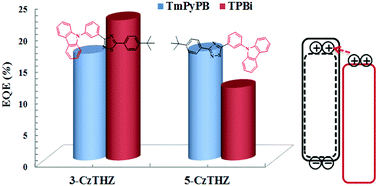Towards highly efficient thermally activated delayed fluorescence devices through a trap-assisted recombination mechanism and reduced interfacial exciton annihilation†
Abstract
In this contribution, two bipolar materials, 3-(3-(9H-carbazol-9-yl)phenyl)-5-(4-(tert-butyl)phenyl)-1,2,4-thiadiazole (3-CzTHZ) and 5-(3-(9H-carbazol-9-yl)phenyl)-3-(4-(tert-butyl)phenyl)-1,2,4-thiadiazole (5-CzTHZ), were developed as host matrices for the TADF emitter 1,2,3,4-tetrakis(carbazol-9-yl)-5,6-dicyanobenzene (4CzPN). By adjusting the host–guest compatibility, two types of emission mechanisms were realized in varied devices according to their different charge-trapping characteristics within the emissive layer (EML). Based on a systematic investigation on both photoluminescence (PL) and electroluminescence (EL) performances, we found that the trap-assisted recombination method could contribute to realizing the full potential of TADF emitters since this mechanism was beneficial to minimizing the energy loss during the host → guest energy transfer (ET) processes. Moreover, the compatibilities between the electron transport layer (ETL) and EML were also fine-tuned to reduce the detriment of interfacial exciton annihilation. Consequently, an outstanding performance was achieved in a 3-CzTHZ-hosted device with the maximum external quantum efficiency (EQE) of 22.2% and power efficiency (PE) of 65.9 lm W−1.



 Please wait while we load your content...
Please wait while we load your content...